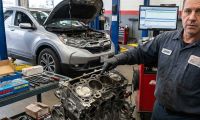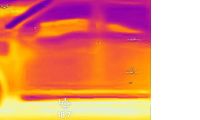The future of automobile efficiency may not be as dependent on electrification as many of us have been led to believe. Witness the Toyota and Honda with their use of the Atkinson cycle. Witness what Ford has done already with its suite of EcoBoost technologies which powers like a V8 in a V6 package. Witness GM’s Ecotech engine; same story. Further witness non-engine efficiency aids like active aerodynamics, dual clutch transmissions and active aerodynamics.
Bottom line message here is simple: Think about it. The industry would not have bought in so readily to the 2016 and 2025 MPG mandates unless they had some technology to back it up; and they do, but it's not all electrification. Since the majority of cars will still be IC engine based, the demise of the IC engine is extremely exaggerated by the green media and many of those in government with their own political and social-change agenda.
There is Yet Another IC Engine Technology
Now make way for the next phase of development of the internal combustion engine - the splitting of the Otto cycle. In simple terms, think of the same four phases of the internal combustion cycle: intake, compression, power and exhaust. Now divide them into two halves; a cold side and a hot side. Better yet, think of a V6 where the left bank acts as a cold intake and compressor, and the right bank tackles the hot power and the exhaust. The gains in efficiency are enormous by comparison to today’s incremental gains from engine advances.
Sure, electrification of the automobile certainly has its advantages, especially at the lower end of the driving spectrum as in the stop & go of city driving. However, the sheer cost of electrification, whether in full or part, cannot compete on a payback basis with the new efficiencies that are about to come out for the internal combustion engine. After all, the Chevy Volt, a grand propulsion system costs $42K and requires government subsidies; similar story for the Nissan Leaf, although it's beating Volt sales 4 to 1 lately.
I know, I know; IC engines are supposedly not green enough to suit green purists. Well, neither are full EVs and plug-in hybrids that replenish their power from coal-burning power plants; and there aren‘t enough wind generators to totally displace power plants feeding the grid; plus our demand for energy around the globe is growing, not shrinking.
With all respect to the hard-hitting, hard-working automotive journalists and the writing trade, I find it silly that so many educated people are trusting their futurist automotive information mostly from media types who perhaps never designed a car in their life, or have limited technical or engineering savvy, so they end up relying far too much on the OEM public relations teams feeding them details through closely-guarded news releases. Where is the trustworthy research that journalism is supposed to glean? (Yeah, I know I'll hear it for this one)
If we as citizens surely deserve automotive efficiency at a cost all of us can afford, then the automotive journalists have to do more than just report on news releases. They need to report, yes; but also cajole the industry toward what is in the best interests of society; otherwise, journalists risk being nothing more than digital recordings for the auto industry. They need to show how and why the cost of electrification has to get much cheaper than it is right now, much like technical advances did for the computer industry. And the simple fact is, automotive electrification is not cheap by any stretch.
Lithium-ion batteries, albeit less expensive than when they were first introduced, are still subject to limited supplies around the world, making their costs subject once again to the politics of foreign countries like China who are hoarding materials.
Likewise, there has been no significant change to battery efficiency and power density in sufficient manner that would finally make the IC engine a has-been, forcing the pull-back of government subsidies from cars like the Nissan Leaf, the Chevy Volt and the Toyota Prius.
Further consider the limited improvement with ionic fluid development that would increase the speed of recharging a li-ion battery, not to mention the lack of charging infrastructure when compared to gasoline stations. Only nano-scale electrodes seem to have made any real headway in this area, but at a cost that is still not making transportation any cheaper.
No, what we need is an internal combustion engine that can get 54.2 MPG, and preferably in the city; an engine design that is scalable from small cars to large trucks; can be configured for gasoline, natural gas or diesel. Is it possible?
Sal Scuderi of Scuderi Group (correction: previously noted as Steven), which holds many split-cycle engine patents, told me in an interview at 2011 SAE World Congress in April that 50 MPG is achievable, but did not specify city or highway. And yes, split-cycle engines can be scalable and can be made to run with gasoline, nat-gas and diesel; and, more important, can be designed with turbos, direct injection and a storage tank with its crossover passage to make an air hybrid that approaches the efficiencies envisioned by the Miller Effect.
Fact is the split-cycle IC engine with its hot and cold side has the thermodynamic potential to deliver both power and efficiency at a cost all can afford; and it has the potential to deliver this efficiency with a 70 percent reduction in pollution; some say even better. The best example for autos is the Scuderi split-cycle, air-hybrid engine.
Yes, I’ve written about this engine before; and, no, I receive nothing in return. But I do believe in its potential to change things, a change that an engineer like me can believe in! (Yes, the pun is intended)
Time for a Decision
The auto industry needs to take this serious enough, designing not for incremental gains but monumental gains in thermodynamic efficiency; which means the auto industry will have to shell out a few more development bucks. They certainly have the cash as they haven’t hired in years.
Problem is, the auto industry bean counters prefer to go on an incremental path toward IC engine efficiency, which explains why it has yet to commit to splitting the cycle. Still they prefer incremental advances, reminding me when pollution controls first appeared as add-on gadgets, thinking it was merely a phase. Before you knew it we had multiple devices on multiple brackets. Point, there was no system approach until somebody stopped the insanity.
C’mon, even I can see the advantages of the split-cycle technology here. I guess what’s needed is some blowout news to put the OEMs over the edge toward full commitment. While we wait, though, there is so much more to do, and time is ticking by.
Point is, the tech level for most OEMs at this time for most IC engines is the about the same. All, however, come short of meeting 2016 and 2025 government mandates, especially that 54.2 MPG. Then again, as Yankee great, Yogi Berra, always said, “It ain’t over til it’s over.”
As I have been touting for a few years now, the IC engine needs a significant makeover beyond the band-aide fixes and dime-at-a time tech introductions. And the time has come to end that kind of Detroit paradigm. We need engine efficiency; we need 50-plus MPG in the city, and we need and want it now! And we want it to be affordable!
Many OEMs prefer any makeover to be within the same manufacturing capabilities we have right now, because it’s cash-flow effective. They need to make a profit; it’s not personal, just business; I get it. Unfortunately, they wait for some go ahead as if from above.
In the meantime, major technical advances are coming from outsiders, like Scuderi Group, Tour Engine, even Achates Power and Cyclone Power. Regardless of who invents and develops the new engine design, the cost advantage of high-volume manufacturing of engines would still be around. That still spells profit margins for the OEMs. The only difference would be in the specific configuration of the engine; and that customization should also appeal to the OEMs.
In plain English, I fully believe the spit-cycle engine technology is about to come into its own; and it’s about time as far as I’m concerned.
Sure, we still need lighter but safer body structures, as weight has always been a major factor. Streamline styling; well we already have that. The advantages of turbos, direct injection, variable valve timing, variable cam timing, cylinder shut down, just to name a few, will not be lost either; but there is that one feature that we seldom consider: air hybridization for cars, hydraulics and air for heavy trucks and busses.
Fact is, we can store energy in compressed air like we can with electrons in batteries and ultra-capacitors; and it’s a heck of a lot cheaper; and that’s just part of the advantage of splitting the cycle.
Yet, why is it so few automotive writers ever mention that fact? On the other hand, why do so many auto engineers seem oblivious or unwilling to talk about split-cycle technology these days? Too busy making incremental changes for a meager 1% gain?
I can tell you why - politics, both corporate and national. That’s right; it seems the government wants electrification no matter what the cost to us as consumers; and corporate bean counters are at odds with engineering expertise.
Now, I favor electrification, too, where it makes sense; but not at a cost where I have to place part of my retirement savings as collateral, or get a subsidy from my tax-paying neighbor who, unless we forget, IS the government.
For the record, Raytheon (NYSE: RTN) recently declared the external combustion steam engine of Cyclone Power as “a game changer” especially for military applications. Well, it’s time for another declaration: So is the split-cycle engine technology for the automobile - a game changer!
-----------------------
About the Reporter: After 39 years in the auto industry as a design engineer, Frank Sherosky now trades stocks, futures and writes articles, books and ebooks via authorfrank.com, but may be contacted here by email: [email protected] and followed in Twitter under @Authorfranks
________________________________________________
Additional Reading:
CAR MBS 2011 reveals auto industry still uncertain on next IC Engine choices
Achates Power addresses commercial truck mileage and emission standards
Why Obama's proposed CAFE standards to 56.2 mpg IS feasible
Michele Bachmann fails to deliver how she would achieve 2 dollar gasoline
Cyclone Power receives tenth international patent for external combustion engine
Raytheon: Cyclone Power's combustion engine game changer
Auto industry compromise with expensive EVs fails the masses
Scuderi Air-Hybrid Engine technology setting up to challenge electric hybrids











Comments
Perhaps a little homework is
Permalink
Perhaps a little homework is in order. The Miller Cycle engine of which you speak has already been produced and sold in the Mazda Millenia as far back as 1995 in North American markets, prior to that elsewhere. Producing 210 horsepower and 210 pounds of torque from a 2.3 liter supercharged V6, this engine achieved 20 miles per gallon (mpg) city, 28 mpg highway, 23 mpg combined. A far cry from 54.2 mpg. Of course, you quoted no power or torque numbers in your article, so a low powered version of this engine could likely produce that kind of fuel economy. Mazda killed the Millenia and the Miller Cycle engine in 2002.
Hey Fact Checker ... you
Permalink
Hey Fact Checker ... you didn't complete your fact-checking. For starters, check out the link below:
http://forums.motortrend.com/70/7301981/the-general-forum/why-hasnt-the-miller-cycle-been-more-widely-utiliz/index.html
The Miller Cycle is and was a GREAT concept that did work to some degree. However, it was "killed" because it did not do what they had hoped! This is where Scuderi Engine comes in. It turns out, you needed THIS technology to "complete" and maximize the benefit of the Miller Cycle. Together, this is unbeatable for an ICE!!! Once this is in the hands of an OEM and you can purchase a car with this engine, you will be smiling as you pass the gas stations where you used to have to stop!!! :-) As for power and torque, that's a bonus!
Check out www.scuderiengine.com for more information.